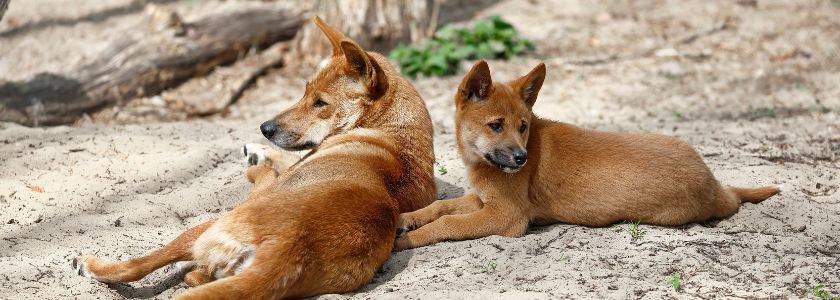Which came first—the dog or the dingo genome? DNA analysis may provide an answer

The takeaway: The dingo genome has been sequenced—and the results may surprise you. New evidence suggests the Australian outback icon represent a unique event in the evolution of the dog.
The dingo is more than just a version of dogs that you might happen upon in the Australian outback.
Dingoes are lean, fast, agile, and strong. Seen in the wild, they do look a lot like a dog out on a run (and without a collar). For many, dingoes symbolize opportunism, being open to new opportunities, and understanding relationships. (Seen in dreams, dingoes can be a sign that the dreamer needs to take a break from work and have some fun—but that’s a story for another time.)
These large carnivorous hunters might occupy a wide swath of the continent, but exactly what they are has been debated for years, with the animals variously considered a form of domestic dog, a subspecies of dog (or wolf), or a fully distinct species of its own. Now, thanks to a groundbreaking genome sequencing investigation, we are closer to understanding the truth about these animals.
Where did dingoes come from?
Scientists believe that dingoes showed up in Australia about 5,000 years ago, migrating to the continent from Asia. Today, there are two types of dingoes—alpine and desert. Dingoes are apex predators and important to Australia’s ecosystem, and while they are canids, it was never clear precisely what they descended from.
Then came along Dr. Bill Ballard, a La Trobe University professor, and a challenge—to find the world’s most interesting genome. The winner was to receive the Pacific Biosciences SMRT Grant, which would pay for the sequencing of the complete genome of a globally important animal. Ballard chose Sandy, a rescue dingo picked up in 2014 who was nursed back to health. Sandy beat out five other animals, including a relative of the dodo, a solar-powered sea slug, and a beetle that emits boiling-hot explosive gas when it is bothered, and Ballard got to work.
DNA testing on dingoes
In Australia, there has long been concern about genetic interference with wild dingo populations from domestic dog genes. Work began in the 1970s to develop a method of skull morphology to determine if a particular animal was a dingo, domestic dog, or hybrid of the two. In the 1990s, a genetic test was developed to determine if an animal was genetically a dingo or not. Other DNA tests were developed to determine dingo presence in domestic dogs.
Most of these dingo DNA tests use microsatellite markers to distinguish between species or breeds. The latest tests use genome-wide single nucleotide polymorphisms (SNPs) to understand an animal’s evolutionary history. For dingo vs. dog determinations, microsatellite makers find the frequency of different alleles in the two animals.
Working in a lab in Arizona, Ballard compared Sandy’s genome to the genomes of five domestic dogs and a wolf from Greenland. He then used a number of sequencing technologies and epigenetic analysis to find what separates the genome of a domestic dog from the genome of a dingo. One of those differences was in number of copies of a gene coding for amylase, an enzyme that helps animals digest starchy foods. As with wolves, dingoes have only one copy of that gene, while breed dogs, have up to 20—probably because in the early days of domesticated dogs, those animals were fed rice, which is starchy and resulted in a selection bias for animals that have more than one copies of the amylase gene. The finding was backed up by an analysis of dog and dingo poop—one dog species had differences in microbiomes, with higher concentrations of the bacteria that break down starchy foods.
Overall, the findings show, the Australian dingo is genetically distinct from domestic dogs, and the species likely descended from wild dogs. Which brings us to the topic of dogs and their genomes.
What is the genome of a dog?
The dog genome is similar in size to the human genome, and consists of approximately 2.5 billion DNA base pairs.
Thanks to efforts such as the Broad Institute’s Dog Genome Project, researchers are learning more about canine genomes, which may serve as a tool for understanding human genomes. Associated projects are studying dog cancer, an effort which may help both humans and dogs survive cancer.
The first dog genome was mapped in 2010, and shows links to human disease and the evolutionary adaptations of canines. That effort was made possible with a framework of about 1,500 loci and another 1,500 map validators, with data from 22,000 SNPs. Domestic dogs, and their relation to wild dogs, wolves, and dingoes, are a fascinating topic of genomic research as most domestication efforts have taken place as the result of artificial selection and selective breeding over just the last couple of centuries.
“The diversity in size, shape, and behavior in the dog is genetically tractable,” wrote the authors of the 2010 study in Genetics that unveiled the mapped genome. “This ‘adaptive’ variation can be couched in the developmental context of an extent progenitor, the wolf, to illuminate the morphological and behavioral antecedents from which breed-defining traits have been derived.”
Why aren’t dog breeds considered a separate species?
Despite their extraordinary differences, domestic dogs are not likely to be labeled as a new species any time soon. While domestic dogs evolved between 17,000 and 33,000 years ago, most breeds were artificially created by humans and done so only in the last 200 years. While a beagle might look and act much different from a Samoyed, they are the same species, Canis lupus familiaris, and are both direct descendants of the grey wolf and their genomes are almost identical. It may take thousands of years for mutations to develop, which could cause inheritable changes to characteristics within populations.
